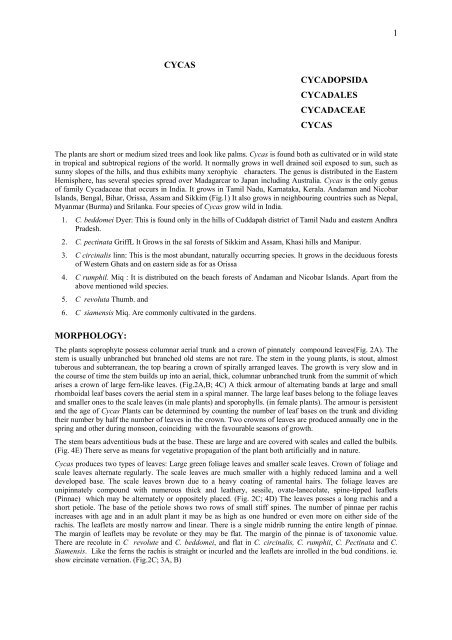Diversity of seed plants and their systematics
Diversity of seed plants and their systematics
Diversity of seed plants and their systematics
Create successful ePaper yourself
Turn your PDF publications into a flip-book with our unique Google optimized e-Paper software.
CYCAS<br />
CYCADOPSIDA<br />
CYCADALES<br />
CYCADACEAE<br />
CYCAS<br />
The <strong>plants</strong> are short or medium sized trees <strong>and</strong> look like palms. Cycas is found both as cultivated or in wild state<br />
in tropical <strong>and</strong> subtropical regions <strong>of</strong> the world. It normally grows in well drained soil exposed to sun, such as<br />
sunny slopes <strong>of</strong> the hills, <strong>and</strong> thus exhibits many xerophyic characters. The genus is distributed in the Eastern<br />
Hemisphere, has several species spread over Madagarcar to Japan including Australia. Cycas is the only genus<br />
<strong>of</strong> family Cycadaceae that occurs in India. It grows in Tamil Nadu, Karnataka, Kerala. Andaman <strong>and</strong> Nicobar<br />
Isl<strong>and</strong>s, Bengal, Bihar, Orissa, Assam <strong>and</strong> Sikkim (Fig.1) It also grows in neighbouring countries such as Nepal,<br />
Myanmar (Burma) <strong>and</strong> Srilanka. Four species <strong>of</strong> Cycas grow wild in India.<br />
1. C. beddomei Dyer: This is found only in the hills <strong>of</strong> Cuddapah district <strong>of</strong> Tamil Nadu <strong>and</strong> eastern Andhra<br />
Pradesh.<br />
2. C. pectinata GriffL It Grows in the sal forests <strong>of</strong> Sikkim <strong>and</strong> Assam, Khasi hills <strong>and</strong> Manipur.<br />
3. C circinalis linn: This is the most abundant, naturally occurring species. It grows in the deciduous forests<br />
<strong>of</strong> Western Ghats <strong>and</strong> on eastern side as for as Orissa<br />
4. C rumphil. Miq : It is distributed on the beach forests <strong>of</strong> Andaman <strong>and</strong> Nicobar Isl<strong>and</strong>s. Apart from the<br />
above mentioned wild species.<br />
5. C revoluta Thumb. <strong>and</strong><br />
6. C siamensis Miq. Are commonly cultivated in the gardens.<br />
MORPHOLOGY:<br />
The <strong>plants</strong> soprophyte possess columnar aerial trunk <strong>and</strong> a crown <strong>of</strong> pinnately compound leaves(Fig. 2A). The<br />
stem is usually unbranched but branched old stems are not rare. The stem in the young <strong>plants</strong>, is stout, almost<br />
tuberous <strong>and</strong> subterranean, the top bearing a crown <strong>of</strong> spirally arranged leaves. The growth is very slow <strong>and</strong> in<br />
the course <strong>of</strong> time the stem builds up into an aerial, thick, columnar unbranched trunk from the summit <strong>of</strong> which<br />
arises a crown <strong>of</strong> large fern-like leaves. (Fig.2A,B; 4C) A thick armour <strong>of</strong> alternating b<strong>and</strong>s at large <strong>and</strong> small<br />
rhomboidal leaf bases covers the aerial stem in a spiral manner. The large leaf bases belong to the foliage leaves<br />
<strong>and</strong> smaller ones to the scale leaves (in male <strong>plants</strong>) <strong>and</strong> sporophylls. (in female <strong>plants</strong>). The armour is persistent<br />
<strong>and</strong> the age <strong>of</strong> Cycas Plants can be determined by counting the number <strong>of</strong> leaf bases on the trunk <strong>and</strong> dividing<br />
<strong>their</strong> number by half the number <strong>of</strong> leaves in the crown. Two crowns <strong>of</strong> leaves are produced annually one in the<br />
spring <strong>and</strong> other during monsoon, coinciding with the favourable seasons <strong>of</strong> growth.<br />
The stem bears adventitious buds at the base. These are large <strong>and</strong> are covered with scales <strong>and</strong> called the bulbils.<br />
(Fig. 4E) There serve as means for vegetative propagation <strong>of</strong> the plant both artificially <strong>and</strong> in nature.<br />
Cycas produces two types <strong>of</strong> leaves: Large green foliage leaves <strong>and</strong> smaller scale leaves. Crown <strong>of</strong> foliage <strong>and</strong><br />
scale leaves alternate regularly. The scale leaves are much smaller with a highly reduced lamina <strong>and</strong> a well<br />
developed base. The scale leaves brown due to a heavy coating <strong>of</strong> ramental hairs. The foliage leaves are<br />
unipinnately compound with numerous thick <strong>and</strong> leathery, sessile, ovate-lanecolate, spine-tipped leaflets<br />
(Pinnae) which may be alternately or oppositely placed. (Fig. 2C; 4D) The leaves posses a long rachis <strong>and</strong> a<br />
short petiole. The base <strong>of</strong> the petiole shows two rows <strong>of</strong> small stiff spines. The number <strong>of</strong> pinnae per rachis<br />
increases with age <strong>and</strong> in an adult plant it may be as high as one hundred or even more on either side <strong>of</strong> the<br />
rachis. The leaflets are mostly narrow <strong>and</strong> linear. There is a single midrib running the entire length <strong>of</strong> pinnae.<br />
The margin <strong>of</strong> leaflets may be revolute or they may be flat. The margin <strong>of</strong> the pinnae is <strong>of</strong> taxonomic value.<br />
There are recolute in C revolute <strong>and</strong> C. beddomei, <strong>and</strong> flat in C. circinalis, C. rumphii, C. Pectinata <strong>and</strong> C.<br />
Siamensis. Like the ferns the rachis is straight or incurled <strong>and</strong> the leaflets are inrolled in the bud conditions. ie.<br />
show eircinate vernation. (Fig.2C; 3A, B)<br />
1

















